Occupational environment monitoring at the wheelchair factory
99,000 ₫
Note: The above price is calculated for one sample, the price may vary depending on the area of the environment that needs monitoring and the movement of the market. For more accurate price support, please refer to the quotation table or contact directly with our consulting staff.
Environmental monitoring of a wheelchair factory is a session of collecting, analyzing, and evaluating factors in the workplace that may harm workers health.
Table of Contents
Toggle1. Overview of wheelchair factory
a. What is a wheelchair factory?
Factory wheelchairs is a production facility specialized in manufacturing various types of wheelchairs or trolleys to support mobility for people with disabilities or those who cannot move normally. Wheelchairs can be used for many purposes, including indoor movement, outdoor use, in medical facilities, and in sports and recreational activities.

b. Production stages in the wheelchair factory
The wheelchair factory usually carries out the following production stages:
- Design: This process includes designing and developing wheelchair models based on customer requirements or market research and analysis.
- Material procurement: Purchasing necessary materials and components to produce wheelchairs, including frames, wheels, accessories, and other parts.
- Processing and assembly: Processing parts such as frames, wheels, seats, and other components. Then, assembling these parts into a complete wheelchair.
- Inspection and testing: Conducting quality and safety inspections of the wheelchair, including checking parts, operational testing, and compliance with standards and regulations.
- Maintenance and repair: Providing maintenance, repair, and servicing for wheelchairs after being sold to customers.

c. Types of machinery used in the wheelchair factory
In the wheelchair factory, several types of machinery and equipment are mainly used for processing and assembling wheelchair parts. Below are some common types of machines in the wheelchair factory:
- Metal cutting machine: Used to cut and process metal parts of wheelchairs such as frames, bases, bearings, and other components.
- Welding machine: Used to weld metal parts together to form the frame and other load-bearing structures.
- Lathe: Used to process and shape metal parts such as axles, wheel axles, support shafts, and other details.
- Grinding machine: Used for grinding and finishing metal parts, creating smooth and precise surfaces.
- Shaping machine: Used to shape plastic or metal parts such as handles, footrests, and other design details on wheelchairs.
- Heat press machine: Used to heat press and bend plastic or composite materials to form parts such as seat backs, armrests, and other wheelchair structures.
- Drilling machine: Used to drill holes and create screw holes on metal or plastic parts.
- High-pressure press: Used for molding and forming complex plastic or composite parts.

d. What occupational diseases may occur for workers in the wheelchair factory?
Workers in the wheelchair factory may encounter some of the following occupational diseases:
- Respiratory diseases: Due to exposure to metal dust, chemicals, and welding fumes, workers may suffer from diseases such as pneumonia, sinusitis, asthma, and other respiratory problems.
- Musculoskeletal peripheral diseases: Working in an industrial environment may cause musculoskeletal injuries, including wounds, fractures, and spinal problems.
- Skin diseases: Exposure to chemicals and protective paint may cause skin irritation, dermatitis, eczema, and other skin issues.
- Ear diseases: Workers may be affected by noise and vibrations from machinery and assembly work, leading to ear problems such as hearing loss and tinnitus.
- Spinal diseases: Working in incorrect postures, lifting and moving heavy parts may cause muscle strain, back pain, and spinal problems.
- Injuries and occupational accidents: Occupational accidents and injuries may occur during work, including collisions, entrapment, cuts, and damage caused by the use of tools and equipment in the factory.
To prevent the above occupational diseases, it is necessary to apply labor protection measures such as ensuring safe working conditions, providing protective equipment, training and education on occupational safety, and controlling harmful factors in the working environment.

e. Common types of wheelchairs on the market
There are many common types of wheelchairs on the market, serving different purposes. Below are some common types of wheelchairs:
- Manual wheelchair: This is a type of wheelchair controlled by hand and pushed by the user. Manual wheelchairs are suitable for short movements and easy use in limited spaces.
- Electric wheelchair: This is a type of wheelchair equipped with an electric motor and control system, allowing users to move easily and conveniently. Electric wheelchairs often have additional adjustable functions such as lifting, reclining, and rotating.
- Sports wheelchair: Specially designed for sports activities such as basketball, soccer, tennis, and weightlifting. Sports wheelchairs have lightweight and flexible structures so that users can participate in sports activities easily.
- Folding wheelchair: This is a type of wheelchair that can be folded into a compact size, convenient for carrying during travel or storage.
- All-terrain wheelchair: Designed for use on difficult terrains such as hills, sand, soil, or rough roads. All-terrain wheelchairs have strong wheels and frames to overcome various terrain conditions.
- Transport wheelchair: This type of wheelchair is designed to transport people with disabilities or mobility difficulties. Transport wheelchairs may have one or more seats and are equipped with accessories such as protection and suspension systems.
- Children’s wheelchair: This is a compact and easy-to-use wheelchair designed for children. Children’s wheelchairs are usually safe and attractive in design, helping children explore and participate in mobility activities.
2. Overview of occupational environment monitoring service
a. What is occupational environment monitoring in the wheelchair factory?
Occupational environment monitoring (or occupational environment measurement) in the wheelchair factory is the activity of collecting, evaluating, and analyzing measurement indicators of occupational environmental factors at the wheelchair factory, in order to implement timely measures, minimize environmental harm to workers’ health, and prevent occupational diseases. Occupational environment monitoring is a mandatory regulation for wheelchair factories.
Occupational environment monitoring plays the most important role in caring for, protecting, and improving workers’ health because the main resource of enterprises and the direct creators of profit are the workers. Workers who are frequently exposed to hazardous occupational factors exceeding permissible standards will have their health affected and may develop occupational diseases.
REGISTER FOR OCCUPATIONAL ENVIRONMENT MONITORING SERVICE
b. Occupational environment monitoring program of Nam Viet
The occupational environment monitoring program of Nam Viet is a program researched by monitoring engineers in the field of occupational safety and environmental protection. With the goal of ensuring health and safety for workers, this program uses modern measurement methods to monitor air quality, water, and microclimate, physical, and dust factors in the working environment. This is a very important program in ensuring a safe working environment and protecting workers’ health.
In addition, the occupational environment monitoring program of Nam Viet also plays an important role in researching and developing new solutions to improve the quality of the working environment. With the dedication and professionalism of the monitoring experts, Nam Viet’s exclusive monitoring program is becoming a breakthrough in the field of occupational safety management and environmental protection in Vietnam.

c. Standardization in occupational environment measurement process
Standardization in the occupational environment measurement process of Nam Viet is a very important aspect in ensuring the quality of measurement results. To ensure the accuracy and reliability of the measurement results, this program uses recognized standards and standardized procedures of Ho Chi Minh City Department of Health. This ensures that the collected data will be highly reliable in the process of evaluating the working environment and making decisions on improving the working environment to protect workers’ health.
These standardized procedures also ensure that measurement results are carried out by monitoring specialists with high qualifications and many years of experience, helping managers and experts trust the results from An Toan Nam Viet and make accurate, valuable decisions in protecting workers’ health and the environment.
By applying standardization in the occupational environment measurement process, Nam Viet demonstrates its commitment to ensuring a safe working environment and protecting workers’ health, while also positively contributing to the development and improvement of occupational safety management and environmental protection quality in Vietnam.
d. Monitoring report results for wheelchair factory
Occupational environment monitoring results are prepared according to Form No. 04, Appendix III issued together with Decree 44/2016/ND-CP and prepared in 02 copies: 01 copy sent to the labor facility that signed the contract for occupational environment monitoring and 01 copy kept at the monitoring organization.
The storage time for occupational environment monitoring results is in accordance with legal regulations, with records stored indefinitely.

e. Frequency of occupational environment monitoring according to legal regulations
According to Clause 2 Article 18 of the Law on Occupational Safety and Hygiene 84/2015/QH13, employers must conduct occupational environment monitoring to assess harmful factors at least once a year.
f. Deadline for submitting occupational environment monitoring results according to legal regulations
The deadline for submission is before December 31 every year, enterprises belonging to production facilities are required to submit occupational environment monitoring reports to the Department of Health in the locality where the production facility, business headquarters, and workers are located.
When there are changes in technology processes, production processes, or when renovating or upgrading labor facilities that may generate new harmful factors affecting workers’ health, enterprises belonging to production facilities must update occupational hygiene records regarding harmful factors that require occupational environment monitoring.
g. Penalty regulations for violations of occupational environment monitoring for employers
According to Article 27 of Decree No. 12/2022/ND-CP dated January 17, 2022, on administrative penalties in the field of labor, social insurance, and Vietnamese workers working abroad under contracts.
- Clause 2: A fine from 2,000,000 – 5,000,000 VND for employers who do not publicly announce to workers at the occupational environment monitoring site and the place of inspection, evaluation, and management of hazardous factors immediately after obtaining occupational environment monitoring results and results of inspection, evaluation, and management of hazardous factors at the workplace.
- Clause 3: A fine from 20,000,000 – 40,000,000 VND for employers who fail to conduct occupational environment monitoring to control harmful effects on workers’ health as prescribed by law.
- Clause 4: A fine from 40,000,000 – 60,000,000 VND for employers who collude with occupational environment monitoring organizations to commit fraud in occupational environment monitoring activities but not to the extent of criminal prosecution.
3. Harmful environmental factors for workers in wheelchair manufacturing factories
In wheelchair manufacturing factories, there may be several harmful environmental factors that can affect the health of workers. Some potentially harmful environmental factors may include:
- Noise: Production activities in wheelchair factories are often accompanied by noise from machinery and production processes. Excessive noise can cause stress, insomnia, and hearing problems.
- Dust and fine particles: The process of manufacturing wheelchairs can generate dust and fine particles from materials such as metal, plastic, and rubber. Inhaling dust and fine particles can cause respiratory irritation, pneumonia, and other health problems.
- Chemicals: During the process of wheelchair production, chemicals such as solvents, adhesives, paints, detergents, and coolants may be used. Exposure to these substances can cause irritation to the skin, eyes, and respiratory system, as well as other health issues such as allergies and organ damage.
- Emissions: Some production processes in wheelchair factories can generate harmful emissions such as carbon monoxide, volatile organic compounds, and exhaust gases from engines. Exposure to emissions can cause respiratory and health problems.
- Temperature and humidity: The working environment in wheelchair factories may experience fluctuations in temperature and high humidity, especially during production and testing. An uncomfortable working environment can cause stress and affect health and work performance.
REGISTER FOR OCCUPATIONAL ENVIRONMENT MONITORING SERVICE
4. Measures to improve the working environment in wheelchair manufacturing factories
To improve the working environment in wheelchair manufacturing factories and protect workers’ health, the following measures can be applied:
- Noise management: Install soundproofing, insulation, and use warning signs about noise to reduce noise to safe levels. Provide workers with hearing protection equipment to minimize the impact of noise.
- Dust and fine particle management: Install effective dust extraction and ventilation systems to reduce the amount of dust and fine particles in the air. Ensure the use of personal protective equipment such as masks and goggles to prevent inhalation of dust and fine particles.
- Chemical management: Use safe and non-toxic chemicals in the production process. Ensure an effective chemical management system, including safe storage, usage, and waste treatment of chemicals.
- Emission control: Apply emission control measures such as installing effective emission treatment systems and using advanced technology to reduce emissions and ensure compliance with environmental regulations.
- Temperature and humidity management: Ensure adjustment of temperature and humidity in the factory to create a comfortable and safe working environment. Use air conditioning and humidity control systems to regulate working conditions.
- Training and education: Train and educate workers about occupational safety, the use of personal protective equipment, safe working procedures, and measures to prevent occupational diseases.
- Regularly organize occupational environment monitoring in factories and enterprises, collect and analyze harmful factors to workers, and then adjust to reduce risks to prevent occupational diseases.
5. Benefits of regular monitoring of wheelchair manufacturing factories
An Toan Nam Viet provides businesses with great advantages when using occupational environment monitoring services in accordance with Decree 44/2016/ND-CP on the management and control of harmful factors in the working environment affecting workers.
- Businesses can proactively control harmful factors at workshops or factories
- Receive consultation and recommendations on measures to minimize harmful factors, improving the quality of the working environment.
- Indirectly protect human resources, the main factor in the development process of businesses
- Minimize the harmful effects of occupational diseases on human health, thereby reducing future treatment costs.
- Improve workers’ health, which leads to better product quality as well as guaranteed and sustained productivity.
- Comply with occupational safety laws, avoiding legal risks.
- Create credibility and professionalism in all aspects, thereby elevating the brand of the business.
The occupational environment monitoring service of Nam Viet is the solution to minimize the harmful effects of occupational diseases, contributing to creating a clean and high-quality working environment.

6. National occupational environment monitoring center
Occupational environment monitoring center of Nam Viet is a professional unit in monitoring and measuring the quality of the working environment throughout all provinces in Vietnam. With a team of experienced monitoring specialists, the center uses modern measuring equipment, ensuring accuracy and reliability.
In addition to providing monitoring services, the center also supports customers in planning, handling, and monitoring occupational environment issues. With the motto “customer is the center,” the center focuses on customer satisfaction, meeting all customer needs, and committing to providing the best solutions for businesses.
REGISTER FOR OCCUPATIONAL ENVIRONMENT MONITORING SERVICE
With investments in technology and human resources, the monitoring center of Nam Viet has become one of the reputable units in the field of occupational environment monitoring in Ho Chi Minh City with the following goals:
- We always value the brand reputation and quality of our products and services.
- We provide customers with the best and most suitable solutions possible.
- With a team of experienced Masters and Engineers, we aim to protect the environment and bring benefits to businesses.
- When working with the Occupational Environment Monitoring team of Nam Viet, companies will receive professional services from experts in the field of monitoring, along with the best cost advantages.
The process of implementing occupational environment monitoring at Nam Viet includes the following basic steps:
- Before carrying out occupational environment monitoring, our company always ensures that the machinery and equipment serving occupational environment monitoring are adjusted and calibrated in accordance with legal regulations.
- Fully and properly implement the occupational environment monitoring procedures committed to the Department of Health.
- Honestly report occupational environment monitoring results to employers.
- In cases where occupational environment monitoring results do not ensure workers’ safety, Nam Viet will support in providing remedial solutions, and the workplaces will implement the following:
- Implement measures to improve working conditions to minimize the impact of harmful factors and prevent occupational diseases.
- Organize health checkups to detect early occupational diseases and work-related illnesses for workers in unsafe working environments.
- Provide allowances in kind for workers in accordance with labor laws.

7. Occupational environment monitoring quotation
To help businesses perform occupational environment monitoring in a professional and effective way, Nam Viet provides customers with a quotation table for occupational environment monitoring services with high quality and reasonable costs.
- Our quotation table provides detailed information on the pricing of the monitoring services we offer, including costs related to travel, measurement, analysis, and reporting results. Customers can be assured of the accuracy and reliability of the monitoring reports we provide.
- We are committed to always offering the most competitive and reasonable prices in the market, and we are also ready to provide consultation and answer any questions about monitoring services quickly and professionally.
- With the quotation table of Nam Viet, customers can easily choose service packages that suit their needs. We are committed to bringing customers the highest satisfaction with professional service quality.
No comments yet

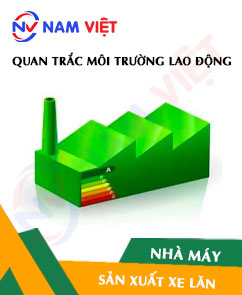
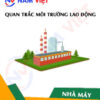
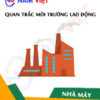


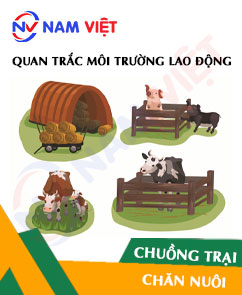

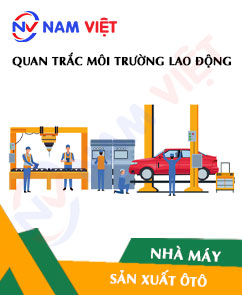

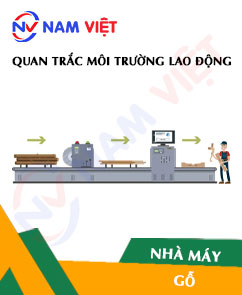

Review Occupational environment monitoring at the wheelchair factory
There are no reviews yet.